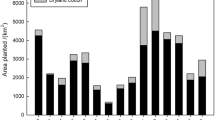Abstract
Research on corn and winter wheat has shown that a critical N concentration in the grain exists above which a yield response to N fertilizer is unlikely. This indicator can be used for post-harvest evaluation of N sufficiency and for mapping N availability in the field, which may be helpful for making future N fertilizer decisions. The purpose of this study was to determine if a critical N concentration in the seed exists for cotton. The study was conducted in the Georgia Coastal Plain during 1998, 1999, and 2001, using a different variety of cotton in each year. In 1998, 12 N fertilizer rates ranging from 38 to 203 kg ha–1 were applied to Delta Pineland 90 at three locations within one field that differed in soil organic matter and clay concentration, and in 1999 and 2001, 6 N fertilizer rates ranging from 22 to 179 kg ha–1 were applied to Stoneville 474 and Delta Pineland 458 in a different field. At all locations, the N concentration in the cottonseed increased linearly with increasing N fertilizer rates. Maximum yields were obtained at less than maximum seed N concentration. Lower seed N concentrations indicated some degree of N deficiency. Based on these results, it appears that a critical N concentration of 35 g kg–1 exists for cottonseeds, above which no yield response to N fertilizer is likely. Information on the spatial distribution of cottonseed N concentrations could therefore help to evaluate the adequacy of N fertilization for cotton, thereby providing a basis for adjustment of N fertilization rates in future crops.
Similar content being viewed by others
References
AOAC 1996. AOAC Method 988.05: Kjeldahl nitrogen analysis. In: Cunniff P. (ed.), Official Methods of Analysis of AOAC International, 16th edn. Vol. 1, 1996. AOAC International, Gaithersburg, MD.
Egelkraut T.M., Kissel D.E., Cabrera M.L. and Adkins W. 2003. Predicting N mineralized in a Georgia Coastal Plain field. Nutr. Cycling Agroecosyst. 66: 1–12.
Elmore C.D., Spurgeon W.I. and Thom W.O. 1979. Nitrogen fertilization increases N and alters amino acid concentration of cottonseed seed protein quality. Agron. J. 71: 713–716.
Goos R.J., Westfall D.G., Ludwick A.E. and Goris J.E. 1982. Grain protein content as an indicator of N sufficiency for winter wheat. Agron. J. 74: 130–133.
Hancock N.I. 1942. Factors in the breeding of cotton for increased oil and nitrogen content. Circular No. 79, April 1942. The University of Tennessee, Agricultural Experiment Station, Knoxville, TN.
Hunt P.G., Bauer P.J., Camp C.R. and Matheny T.A. 1998. Nitrogen accumulation in cotton grown continuously or in rotation with peanut using subsurface microirrigation and GOSSYM/ COMAX management. Crop Sci. 38: 410–415.
Kilmer V.J. and Alexander L.T. 1949. Methods of making mechanical analysis of soils. Soil Sci. 68: 15–24.
Kirsten W. 1983. Organic Elemental Analysis: Ultramicro, Micro, and Trace Methods. Academic Press/Harcourt Brace Jovanovich, New York.
Leffler H.R., Elmore C.D. and Hesketh J.D. 1977. Seasonal and fertility related changes in cottonseed protein quantity and quality. Crop Sci. 17: 953–956.
Nelson W.L. 1949. The effect of nitrogen, phosphorus, and potash on certain lint and seed properties of cotton. Agron. J. 41: 289–293.
Pierre W.H., Dumenil L., Jolley V.D., Webb J.R. and Shrader W.D. 1977a. Relationship between corn yield, expressed as a percentage of maximum, and the N percentage in the grain: I. Various N-rate experiments. Agron. J. 69: 215–220.
Pierre W.H., Dumenil L. and Henao J. 1977b. Relationship between corn yield, expressed as a percentage of maximum, and the N percentage in the grain: II. Diagnostic use. Agron. J. 69: 221–226.
Priestly C.H.B. and Taylor R.J. 1972. On the assessment of surface heat flux and evaporation using large scale parameters. Monthly Weather Rev. 100: 81–92.
Reference Soil Test Methods for the Southern Region of the United States 1983. Southern Cooperative Series Bulletin 289. The University of Georgia College of Agriculture Experiment Stations, Athens, GA.
Sawan M.Z., El-Farra A.E.H.A. and El-Latif S.A. 1988. Cottonseed, protein and oil yields and oil properties as affected by nitrogen and phosphorus fertilization and growth regulators. J. Am. Oil Chemists' Soc. 65: 948–951.
Author information
Authors and Affiliations
Rights and permissions
About this article
Cite this article
Egelkraut, T., Kissel, D., Cabrera, M. et al. Nitrogen concentration in cottonseed as an indicator of N availability. Nutrient Cycling in Agroecosystems 68, 235–242 (2004). https://doi.org/10.1023/B:FRES.0000019461.39144.29
Issue Date:
DOI: https://doi.org/10.1023/B:FRES.0000019461.39144.29




